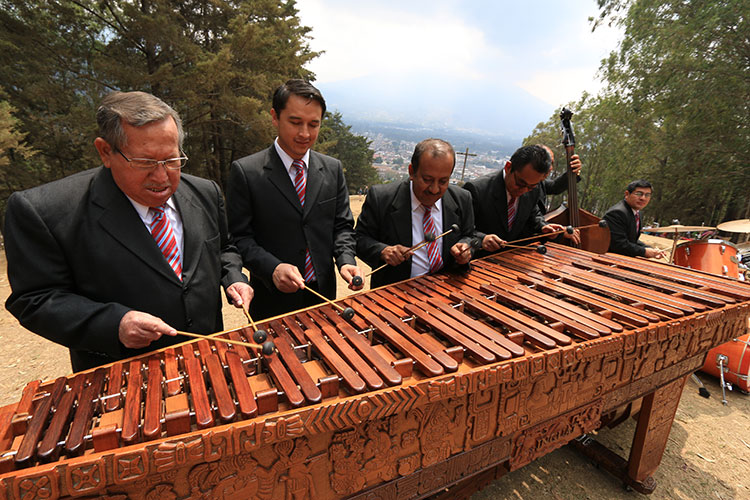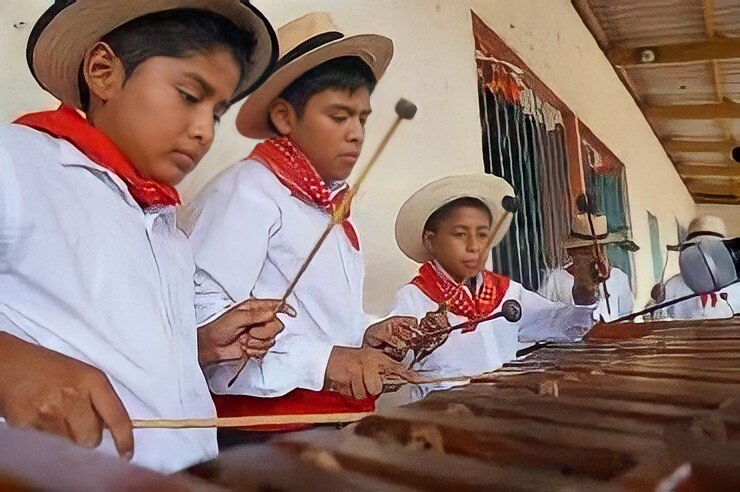La Marimba: Guatemala’s National Instrument
By Carmen Maria Urizar-Avila
Image: Instituto Guatemalteco de Turismo
Serving as the national instrument since 1978, the marimba’s origins reach far past that of the twentieth century. Its intricate and innovative craftsmanship is one of the things that makes it such a big symbol of Guatemalan pride and an integral aspect of the culture. Songs that are played on the marimba can be enjoyed in many different ways from dancing with a partner or having a typical Guatemalan breakfast with loved ones.
History
Image: Gobierno de Guatemala
To this day, the actual origin of the marimba has never been one-hundred percent confirmed; however, it is believed to have originated within African culture. Between 1535 and 1600, the Spanish Monarchy began selling African slaves to colonizers in Latin America. During this time, it is said that African slaves established the instrument that is widely recognized as the marimba or xylophone through the use of wood and gourds fitted with chayote or pork tripe.
It is also speculated that the marimba originated within African culture since the word comes from an African language called Bantú. The word marimba can be broken into two parts. The first being ma which means ‘several keys’ in Bantú and the second part rimba which refers to a ‘flat object that pokes out’ that can be interpreted to mean ‘keys’ as well.
The marimba’s structure is composed of wooden notes/keys that vary in length. Below the wooden keys lay wooden or gourd resonators that allow for sounds to be produced through the act of vibration. Each gourd or wooden resonator is specifically tuned to its corresponding key. The sound is actually produced because the wooden or gourd resonator is fitted with a pork tripe or chayote which later vibrates when the keys are played. The mallet that is used to hit the marimbas keys are usually made of wood with rubber, plastic, or wood heads that are covered in some type of strong string like yarn or cord.
It is also important to note that because of the variation and diversity in materials that are used to make the marimba, the sound of each individual instrument can vary. An example of factors that can be considered in regards to the sound that a marimba makes are the length and shape of the keys and the specific wood used in fabricating them.
Guatemalan Significance
Image: Portal MCD
Another way in which the marimba is unique is that it can be played in many different ways. Since it's such a large instrument with several keys, multiple people can play it at the same time. It is also very common for each person playing to use more than one mallet in each hand in order to cover more keys on the marimba. Although it takes several years to master the art of playing the marimba with just one mallet in each hand, once the musician gets comfortable enough, the act of using two mallets in one hand adds even more melody to the song being played. In Guatemala, it is more common for the marimba to be played with multiple people. Given that the marimba is such an integral part of Guatemalan culture, it is almost always offered as an optional (if not a mandatory) music class in schools for students to learn how to play the marimba.
Image: Prensa Libre, Edwin Castro
Classical Marimba Songs
The practice of playing the marimba is something that is popular within the rural and urban communities of Guatemala. Songs played on marimbas can be upbeat and lively, as well as solemn and nostalgic. Many of the classically popular songs played on marimbas in Guatemala convey the emotion of important historical events, past loves, and the affection that one has to their nation.
Noche de Luna Entre Ruinas
Image: el Quetzalteco
Composed by Mariano Valverde, Noche de Luna Entre Ruinas (Moonlight Among the Ruins) is inspired by a catastrophic earthquake that hit the city of Quetzaltenango in 1902. Known as the San Perfecto earthquake, this natural disaster left the city completely destroyed and the Guatemalan people devastated. Possibly every Guatemalan knows of this song and although people who experienced the earthquake are no longer alive, present day Guatemalans can feel the somber heartache for those who lived through the event. Noche de Luna Entre Ruinas is a song that will continue to be one of the most popular and heartfelt tunes in Guatemala.
Luna de Xelajú
Undoubtedly, Luna de Xelajú (Moon of Xelajú) is one of the most popular songs– if not the most popular within Guatemalan marimbas repertoire and Guatemalan culture overall. This song was composed by Francisco Paco Pérez and inspired by his lover at the time, Eugenia Cohen Alcaheé. It is said that this masterpiece was created one night where Pérez was sitting under the moonlight missing his love, that he was inspired to compose Luna de Xelajú. This popular song is not limited to an instrumental version played on the marimba and its lyrics tell the story where Pérez is singing to the moon as he thinks of his love, Eugenia.
This adaptation of Luna de Xelajú is played by a group of marimba players called ‘Marimba Chapinlandia’. They are a very famous band in Guatemala and usually perform songs in marimba orquesta which means that there are other instruments accompanying the marimba like the drums and the güiro.
Today, the marimba continues to be a staple in Guatemalan culture. If you have ever visited or plan to visit Guatemala, you will experience listening to the marimba being played in places like the airport, restaurants, and malls. Whether classical songs like Luna de Xelajú, Noche de Luna Entre Ruinas, Vals Para Mi Madre are being played, once you hear the marimba it won't be hard to distinguish its uniqueness and it will be impossible to equate it to another instrument.
Sources:
Aceituno López , Axel Adolfo. “‘Evolución De La Marimba Orquesta En Guatemala.’” Cuidad de Guatemala, Universidad de San Carlos de Guatemala, Universidad De San Carlos De Guatemala, Facultad De Humanidades Departamento De Arte , 1999, pp. 5–10.
CASTRO, por EDWIN. Historia De La MARIMBA: Símbolo Patrio. 18 Feb. 2019, www.prensalibre.com/vida/escenario/la-marimba-es-instrumento-nacional-y-simbolo-patrio-de-guatemala/.
CULTURA, por REDACCIÓN. “Noche De Luna Entre Ruinas, Un Vals Que Llena De Nostalgia a Los Guatemaltecos.” Prensa Libre, 5 Feb. 2016,
Deportes, -Ministerio de Cultura y. “La Marimba Guatemalteca Celebrará Dos Años De Ser Patrimonio Cultural De Las Américas.” Portal MCD, 6 Feb. 2017, mcd.gob.gt/la-marimba-guatemalteca-celebrara-dos-anos-de-ser-patrimonio-cultural-de-las-americas/.
Gabriela. “El Desamor Que Inspiró La Canción Luna De Xelajú.” Aprende Guatemala.com, 14 Feb. 2019, aprende.guatemala.com/cultura-guatemalteca/general/historia-cancion-luna-de-xelaju/.
Galicia, por Néstor. “1902: El Terremoto De San Perfecto Sacude El Occidente Del País.” Prensa Libre, 18 Apr. 2018, www.prensalibre.com/hemeroteca/terremoto-de-1902-destruyo-quetzaltenango/.
Leslie. “La Historia Que Tal Vez No Conocías Sobre La Marimba.” Aprende Guatemala.com, 19 Feb. 2021, aprende.guatemala.com/cultura-guatemalteca/civismo/la-marimba-simbolo-patrio-de-guatemala/.
Marimba Chapinlandia. “YouTube.” Marimba Chapinlandia - Luna de Xelaju, uploaded by Difosa Music, 31 Aug. 2017, www.youtube.com/watch?v=TlZvDAOPIow&feature=youtu.be.
Marimba - History. www.vsl.co.at/en/Marimba/History.
“Marimba De Concierto Del INGUAT.” INGUAT, 22 Dec. 2019, www.inguat.gob.gt/index.php/servicios/otros-servicios/espectaculos2/21-espectaculos-inguat/123-marimba-de-concierto-del-instituto-guatemalteco-de-turismo.
“Marimba.” Encyclopædia Britannica, Encyclopædia Britannica, Inc., www.britannica.com/art/marimba.
Rager, Daniel, "The History of the Marimba" (2008). Music Faculty Publications. 1. https://engagedscholarship.csuohio.edu/clmusic_facpub/1
Valverde, Mariano. “NOCHE DE LUNA ENTRE RUINAS MARIMBA CHAPINLANDIA.” YouTube, uploaded by Gatonelblu, 1 Feb. 2013, www.youtube.com/watch?v=giekEkZ7KW0&t=3s.





